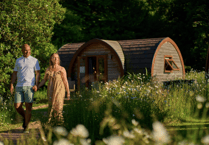MORE than 700 people have volunteered with a Forest programme which has reached its mid-way point.
Seven hundred and fifteen people, living mainly within the Forest of Dean, have volunteered with Foresters’ Forest since the start of the programme, with their time, as a cumulative total value for community volunteer hours currently standing at £618,000. And 80 per cent of the volunteers who completed a survey say that they were able to use their skills doing meaningful work and feeling they were making a difference to the future of the Forest of Dean.
These are just a few of the key findings in the second detailed evaluation of the Foresters’ Forest National Lottery Heritage funded programme, completed by The Countryside and Community Research Institute between September 2019 and February 2020. The evaluation reported on interviews with lead representatives of the 38 projects that make up the programme and included a detailed online survey of the wider Forest of Dean community.
The results reveal many encouraging findings at the mid-way point in this five year programme.
In terms of programme awareness locally, a total of 80 per cent of those surveyed in 2019 indicated they had heard of Foresters’ Forest before completing the survey, compared to 44 per cent of the 2018 survey sample. 41 per cent of respondents also confirmed that they had taken part in some form of activity, event, or training course, and about a third indicated they had done some volunteer work with the Foresters’ Forest projects.
Sue Middleton, programme manager, Foresters’ Forest comments: “Delivery of the Foresters’ Forest programme relies heavily on voluntary activity so it is particularly useful to note at this mid-programme stage that more people are getting involved. It’s great to hear how much our volunteers enjoy taking part, what they’ve learned and why they want to look after our Forest more in future.”
The natural heritage projects involving wildlife, water, or tree surveys tend to be more demanding of volunteer time, as is the archaeological project. Of those who completed the survey and confirmed the three main types of volunteering they had done, 21 per cent said they had taken part in Love Your Forest community litter picking, 18.7 per cent had supported ‘Waterways, ponds & mires’ volunteering activity and 15.4 per cent had taken part in ‘Buried Heritage’ archaeology work.
The Programme’s Project Leaders noted that in most cases residents of the Forest of Dean were identified as primary beneficiaries in relation to outcomes for people, such as developing skills, learning about heritage and volunteering opportunities.
Those benefiting tend to be those who get engaged in volunteering or in project related activities. These are often middle-aged, older and retired people, although in some projects young people were also identified as getting involved.
A range of volunteers’ personal stories shared a wide range of benefits they have experienced, including development of skills, learning, improved understanding and development of friendships and wider social relations.
One volunteer, Mervyn, has involved himself in a wide range of Foresters’ Forest projects including Birds, Ponds, Waterways, Reptiles, Veteran Trees and Sphagnum Moss Surveying and said: “The Waterways survey is a particular joy. It is massively fun, like going back to pond dipping as a child! It is impacting on my ideas as chair of the GNS. Inspiring younger people feels very important. I want to help spark the same love of nature in young people that my mother gave to me.”
While Gwynneth, volunteer for the Buried Heritage project says: “Volunteering on the project has been full of positives. I’ve made friends, such as Cathy who I’m working with on the research project and Elaine and David who I work with on the LIDAR project. It feels great to be involved in something that is all about looking after the Forest of Dean and keeping it special for future generations.”
Heather Lilley, Forestry England’s community engagement and communications officer says: “The Foresters’ Forest project has enabled so many more people to really get involved and play their part in looking after our Forest. It is a key objective of Forestry England to encourage and support people to volunteer in their local woods, so we are pleased that people in the Forest of Dean have taken the opportunity and it is clear from these personal stories that it has helped to change some people’s lives. We look forward to planning further projects and opportunities in the next half of the Foresters’ Forest project!”
Finally, also commenting on the mid-programme evaluation results, Chris McFarling, District Councillor and Foresters’ Forest Programme Board Chair says: “Most encouraging, for me, is that we’ve seen younger people volunteering to help these projects flourish, and enjoying the engagement with our wonderful cultural, built and natural history.
“When younger people discover the value of their inheritance; how special and fragile it is, they are much more likely to respect and care for it in the future. Sustaining interest in our unique Forest heritage is critically important if we are to build on this outstanding volunteering legacy when the programme funding finishes.”
To find out more about the programme see forestersforest.uk





Comments
This article has no comments yet. Be the first to leave a comment.